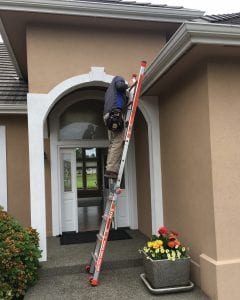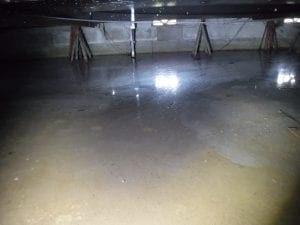Whether you are selling your home or just want to care for your investment, one of the greatest threats to any home in the Pacific Northwest surrounds us all the time. It falls from the sky in the form of rain sleet and snow, and fills the spaces in the ground as it makes its way to Puget Sound. Water is a force of nature that every homeowner must contend with at one time or another, but with some expert advice from Dwayne Boggs of Boggs Inspections Services, you’ll be able to spot the signs of a drainage problem around your home.
Take a Walk in the Rain
“When assessing drainage issues around the home, a rainy day is a good time to look for problems,” says Dwayne. Walk all around the outside of your home. Look up and down, inside and out, to find signs of concern. Use all your senses. Watch the water as it moves away from your home, listen for dripping or running, feel for sogginess and waterlogged soil in the ground beneath your feet, and even smell for signs of a problem.

First Line of Defense
Your gutters and downspouts work together to direct all of the precipitation from your roof to a system that moves it away from your home. If your gutters are filled with debris, water can wick up the roof or cascade down the side of the house. Clear those gutters to make sure the water can make it to the downspouts. Then, make sure downspouts and splashguards are not blocked by leaves, vegetation or other debris.
Red Flags
Pooling water in the yard or flower beds adjacent to your home is one of the major signs of concern. When homes are built, they are graded with a natural slope that gently moves water away from the foundation. If you see pools of water, erosion, soil compaction or other surface conditions may have affected the grading of the land around your home and this issue should be addressed to prevent small issues from becoming big problems.
Water in the basement is another clear warning sign of a drainage issue. But even if you don’t see water, you may have a moisture issue. Look for staining on basement walls. Water stains come in many colors, white, rusty brown, and grey black are the most common. “White staining is generally efflorescence,” says Dwayne, “a type of mineral staining that is left behind when moisture evaporates.” Rusty brown stains are usually caused by iron ochre infiltration, something that occurs when moisture seeps in through iron rich soils. Grey and black stains are usually mold, which can only grow in the presence of moisture. Basements are often filled with cool stale air, but strong musty smells can be a sign of water that is not draining properly away from the home.

Cracks in the foundation can let water in, or they can actually be caused by poor drainage. Look for cracks, seeping water, or pooling in low points, paying attention to carpets for staining or sogginess.
“Even if you don’t have a basement, standing water in your crawlspace is still a big concern,” Dwayne says. Standing water or high levels of moisture can cause mold. It can also cause rot and weaken structural support. And moisture in the crawlspace can make the underside of your home more hospitable to destructive pests like carpenter ants, he adds.
Perimeter Drainage Systems
Some homes rely on good grading and gravity to move water away from them. Others have subsurface systems with trenches, drain pipe and weeping tiles that are part of a French drain. “Over time these systems can require maintenance, especially in older homes,” says Dwayne. Sometimes tree roots grow into the drain pipes, blocking the flow of water away from the home. Other times the weeping tiles are old—made of clay, they become damaged and need to be replaced.

Remember, if you decide to do any of this work yourself, contact the Washington Utility Notification Center before you begin digging around. Hitting a gas line would only add to your troubles.
Often, a subsurface drain system is connected to a sump pump. Regularly check your sump pump pit for debris that could clog the pump. Keep an eye out for signs of wear on the pump. Finally, test the pump by adding a couple of gallons of water to the pit to ensure the pump turns on when the switch is reached or the float raises. Remember to unplug the pump before attempting to clear any blockages or do work on the pump itself.
If your subsurface drain system appears to be working, but you detect signs of poor drainage, it’s time to contact a professional before more damage is done.
Proper drainage around your home is just one way you can keep your investment safe from moisture damage. Still not sure what you should be looking for, or maybe you would like a second pair of trained eyes to give you some piece of mind? Contact Boggs Inspection Services to schedule a home inspection at 360-480-9602.
Sponsored


































